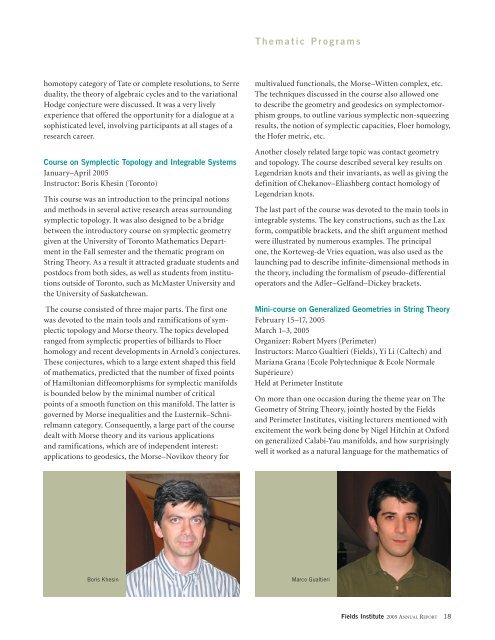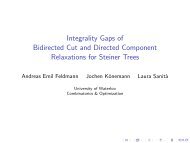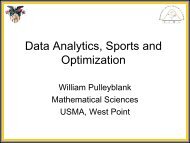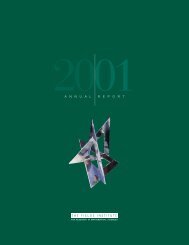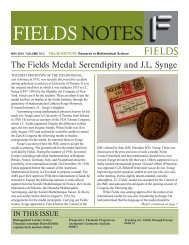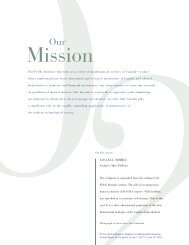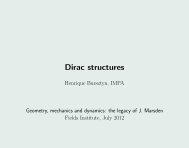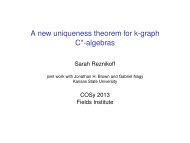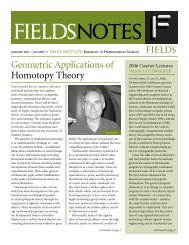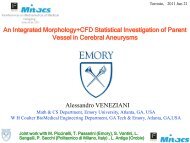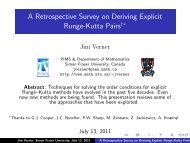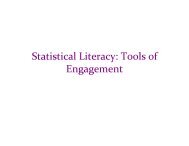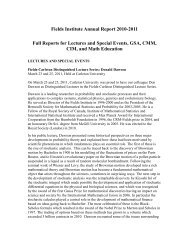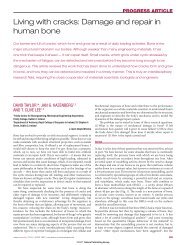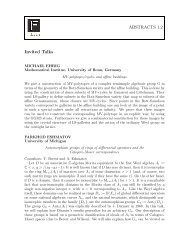Annual Report 2005 - Fields Institute - University of Toronto
Annual Report 2005 - Fields Institute - University of Toronto
Annual Report 2005 - Fields Institute - University of Toronto
You also want an ePaper? Increase the reach of your titles
YUMPU automatically turns print PDFs into web optimized ePapers that Google loves.
homotopy category <strong>of</strong> Tate or complete resolutions, to Serre<br />
duality, the theory <strong>of</strong> algebraic cycles and to the variational<br />
Hodge conjecture were discussed. It was a very lively<br />
experience that <strong>of</strong>fered the opportunity for a dialogue at a<br />
sophisticated level, involving participants at all stages <strong>of</strong> a<br />
research career.<br />
Course on Symplectic Topology and Integrable Systems<br />
January–April <strong>2005</strong><br />
Instructor: Boris Khesin (<strong>Toronto</strong>)<br />
This course was an introduction to the principal notions<br />
and methods in several active research areas surrounding<br />
symplectic topology. It was also designed to be a bridge<br />
between the introductory course on symplectic geometry<br />
given at the <strong>University</strong> <strong>of</strong> <strong>Toronto</strong> Mathematics Department<br />
in the Fall semester and the thematic program on<br />
String Theory. As a result it attracted graduate students and<br />
postdocs from both sides, as well as students from institutions<br />
outside <strong>of</strong> <strong>Toronto</strong>, such as McMaster <strong>University</strong> and<br />
the <strong>University</strong> <strong>of</strong> Saskatchewan.<br />
The course consisted <strong>of</strong> three major parts. The first one<br />
was devoted to the main tools and ramifications <strong>of</strong> symplectic<br />
topology and Morse theory. The topics developed<br />
ranged from symplectic properties <strong>of</strong> billiards to Floer<br />
homology and recent developments in Arnold’s conjectures.<br />
These conjectures, which to a large extent shaped this field<br />
<strong>of</strong> mathematics, predicted that the number <strong>of</strong> fixed points<br />
<strong>of</strong> Hamiltonian diffeomorphisms for symplectic manifolds<br />
is bounded below by the minimal number <strong>of</strong> critical<br />
points <strong>of</strong> a smooth function on this manifold. The latter is<br />
governed by Morse inequalities and the Lusternik–Schnirelmann<br />
category. Consequently, a large part <strong>of</strong> the course<br />
dealt with Morse theory and its various applications<br />
and ramifications, which are <strong>of</strong> independent interest:<br />
applications to geodesics, the Morse–Novikov theory for<br />
T h e m a t i c P r o g r a m s<br />
Boris Khesin Marco Gualtieri<br />
multivalued functionals, the Morse–Witten complex, etc.<br />
The techniques discussed in the course also allowed one<br />
to describe the geometry and geodesics on symplectomorphism<br />
groups, to outline various symplectic non-squeezing<br />
results, the notion <strong>of</strong> symplectic capacities, Floer homology,<br />
the H<strong>of</strong>er metric, etc.<br />
Another closely related large topic was contact geometry<br />
and topology. The course described several key results on<br />
Legendrian knots and their invariants, as well as giving the<br />
definition <strong>of</strong> Chekanov–Eliashberg contact homology <strong>of</strong><br />
Legendrian knots.<br />
The last part <strong>of</strong> the course was devoted to the main tools in<br />
integrable systems. The key constructions, such as the Lax<br />
form, compatible brackets, and the shift argument method<br />
were illustrated by numerous examples. The principal<br />
one, the Korteweg-de Vries equation, was also used as the<br />
launching pad to describe infinite-dimensional methods in<br />
the theory, including the formalism <strong>of</strong> pseudo-differential<br />
operators and the Adler–Gelfand–Dickey brackets.<br />
Mini-course on Generalized Geometries in String Theory<br />
February 15–17, <strong>2005</strong><br />
March 1–3, <strong>2005</strong><br />
Organizer: Robert Myers (Perimeter)<br />
Instructors: Marco Gualtieri (<strong>Fields</strong>), Yi Li (Caltech) and<br />
Mariana Grana (Ecole Polytechnique & Ecole Normale<br />
Supérieure)<br />
Held at Perimeter <strong>Institute</strong><br />
On more than one occasion during the theme year on The<br />
Geometry <strong>of</strong> String Theory, jointly hosted by the <strong>Fields</strong><br />
and Perimeter <strong>Institute</strong>s, visiting lecturers mentioned with<br />
excitement the work being done by Nigel Hitchin at Oxford<br />
on generalized Calabi-Yau manifolds, and how surprisingly<br />
well it worked as a natural language for the mathematics <strong>of</strong><br />
<strong>Fields</strong> <strong>Institute</strong> <strong>2005</strong> ANNUAL REPORT 18


